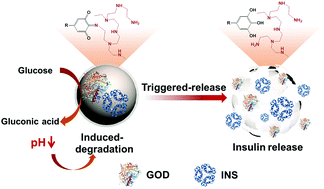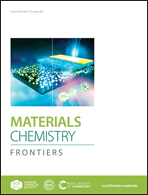Mussel-inspired capsules toward reaction-triggered cargo release†
Abstract
Exploring systems with distinct stimuli-response properties is vital for controlled release. In our study, a reaction-triggered system based on enzyme-encased capsules is constructed through mussel-inspired chemistry for controlled release of insulin (INS, a kind of protein hormone for diabetes mellitus treatment). In detail, glucose oxidase (GOD) and INS were first entrapped in CaCO3 particles through a co-precipitation method. Tannic acid (TA, a natural polyphenol) was adhered on the particle surface and conjugated with polyethyleneimine (PEI) through a Schiff base reaction and electrostatic interactions, thus acquiring TA–PEI (TP) capsules encasing GOD and INS. The GOD inside the capsules catalysed the oxidation of glucose to form gluconic acid, which caused the enrichment of protons (H+) around the capsules. The decrease of the pH value further broke the C![[double bond, length as m-dash]](https://www.rsc.org/images/entities/char_e001.gif) N bond in the capsule wall, which led to the disassembly of the capsules and the release of INS. The capsular system could continuously release 73.1% of the INS in 3 h, and exhibited a specific response to glucose. Combined with the facile and mild preparation of the enzyme-encased capsules, it was expected that the as-constructed capsular system could be applied for the delivery and controlled release of a broad range of cargoes.
N bond in the capsule wall, which led to the disassembly of the capsules and the release of INS. The capsular system could continuously release 73.1% of the INS in 3 h, and exhibited a specific response to glucose. Combined with the facile and mild preparation of the enzyme-encased capsules, it was expected that the as-constructed capsular system could be applied for the delivery and controlled release of a broad range of cargoes.



 Please wait while we load your content...
Please wait while we load your content...